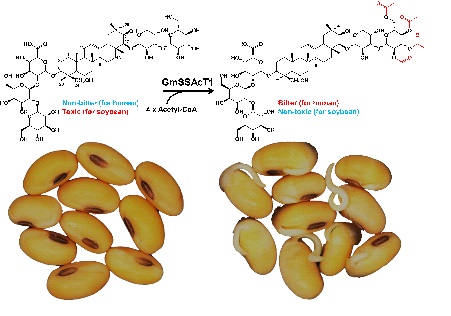Recently, researchers from Dr. WANG Guodong's group in the Institute of Genetics and Developmental Biology (IGDB), Chinese Academy of Sciences (CAS), systematically investigate the physiological functions of type-A soyasaponin acetylation.
Soyasaponins, oleanane-type triterpenoid saponins found abundantly in soybean (Glycine max L.) seeds, especially in hypocotyls, fall into four groups based on moieties at C21 and C22 positions of the soyasapogenol (aglycone) carbon backbone. Among them, type-A soyasaponins feature hydroxyl groups at both C21 and C22, with sugar chains typically at C3 (usually three sugar units) and C22 (usually two sugar units).
Past studies reveal that acetylated sugars in type-A soyasaponins contribute to the undesirable bitter taste in soybean-derived foods, whereas null-acetyl type-A soyasaponins lack this bitterness. However, the specific acyltransferase(s) responsible for acetylation during type-A soyasaponin biosynthesis remain unclear. Although targeting the type-A soyasaponin acetyltransferase could enhance soybean taste properties, no soybean accession or artificial mutant, isolated through extensive screening, has been characterized for high accumulation of partial-/null-acetyl type-A soyasaponins in the last three decades.
WANG’s team identified a candidate BAHD acyltransferase gene named GmSSAcT1 through gene co-expression analysis and the soybean hairy root system, and biochemically established that GmSSAcT1 catalyzes sequential acetylation reactions on type-A soyasaponins. Disrupting GmSSAcT1 via CRISPR/Cas9 genome editing led to the complete loss of type-A soyasaponins, resulting in an accumulation of null-acetyl type-A soyasaponins and causing a seed germination defect.
While the precise mechanism of phytotoxicity in null-acetyl soyasaponin A needs further investigation, this study underscores GmSSAcT1's dual role as a detoxification enzyme reducing toxic compounds in soybean seeds and as a potential target for breeding less bitter soybean varieties. Despite the germination issue in ssact1 mutant seeds, the research suggests the possibility of selecting soybean varieties with reduced soyasaponin A and increased null-acetyl soyasaponin A levels from a large soybean natural population.
The research results were published online in Journal of Integrative Plant Biology entitled "A recently evolved BAHD acetyltransferase, responsible for bitter soyasaponin A production, is indispensable for soybean seed germination".
This work is supported by grants from the National Key R&D Program of China, “Priority Research Program” of the Chinese Academy of Sciences, and the State Key Laboratory of Plant Genomics of China.
Figure: A challenging dilemma in improving soybean seed quality (Image by IGDB). The BAHD acetyltransferase GmSSAcT1 plays a crucial role in soybean seed germination by catalyzing the conversion of null-acetyl type-A soyasaponins (which are non-bitter but toxic) to type-A soyasaponins (which are non-toxic but bitter). This enzymatic activity is essential for the successful germination of soybean seeds. Image courtesy of Drs. Jia Yuan and Guodong Wang from IGDB.
Contact:
Dr. WANG Guodong
 Figure: A challenging dilemma in improving soybean seed quality (Image by IGDB). The BAHD acetyltransferase GmSSAcT1 plays a crucial role in soybean seed germination by catalyzing the conversion of null-acetyl type-A soyasaponins (which are non-bitter but toxic) to type-A soyasaponins (which are non-toxic but bitter). This enzymatic activity is essential for the successful germination of soybean seeds. Image courtesy of Drs. Jia Yuan and Guodong Wang from IGDB.Contact:Dr. WANG GuodongInstitute of Genetics and Developmental Biology, Chinese Academy of Sciences
Figure: A challenging dilemma in improving soybean seed quality (Image by IGDB). The BAHD acetyltransferase GmSSAcT1 plays a crucial role in soybean seed germination by catalyzing the conversion of null-acetyl type-A soyasaponins (which are non-bitter but toxic) to type-A soyasaponins (which are non-toxic but bitter). This enzymatic activity is essential for the successful germination of soybean seeds. Image courtesy of Drs. Jia Yuan and Guodong Wang from IGDB.Contact:Dr. WANG GuodongInstitute of Genetics and Developmental Biology, Chinese Academy of Sciences CAS
CAS
 中文
中文




.png)
